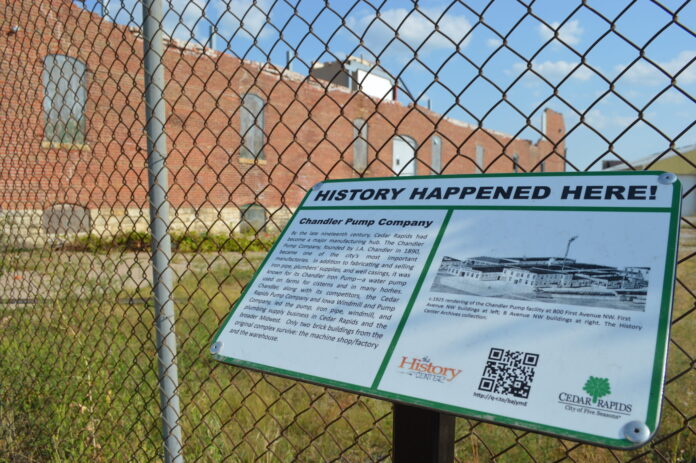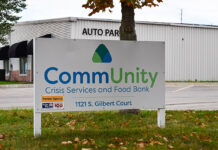
Iowa’s 2020 derecho almost wiped out plans to transform the historic Chandler Pump building into supportive housing for Willis Dady Homeless Services.
The top floor of the two-story building, 707 B Ave. NW, was obliterated by the hurricane-strength windstorm, leaving the rest of the 1903-built brick structure at risk.
More than three years later, the now one-story building was celebrated with a ribbon-cutting Thursday, Jan. 25, as the 13-unit Chandler Pump Apartments, for permanent supportive housing for Willis Dady clients.
“It’s an amazing opportunity,” Aaron Amundson, development director for Willis Dady, said at the ribbon-cutting ceremony.
Mr. Amundson noted that with just a few touch-ups left to do, clients will begin moving into the apartments in February. Weekly case management will be provided to each household.
There are “absolutely” more people on Willis Dady’s waiting list for permanent housing than available units, he said, and while most of the apartments are efficiencies, some are multi-bedroom, so the building will likely house more than 13 people.
Some of those might participate in Willis Dady Works, the employment hub next door that initially had been planned for the first floor of the Chandler Pump building, with the second floor envisioned before the derecho as housing, Mr. Amundson said.
One of the work projects in the employment hub involves recycling the metal and other components of used mattresses, with Willis Dady clients earning a wage and tons of materials kept out of the landfill.
With the derecho decimating many buildings in Cedar Rapids, and across Iowa, an opportunity presented itself next door to the Chandler Pump building, when the McLanahan company moved out of their damaged warehouse/office at 800 First Ave. NW, said Scott Olson, who served as project coordinator for Willis Dady.
That building, also an early-1900s structure, had been repurposed as office space, with a newer addition.
Mr. Olson, an architect who serves on the Cedar Rapids City Council, said the building was sold at less than half price to Willis Dady, with insurance proceeds also provided toward the then-expanded project.
What was a $2.9 million project became a $3.4 million project, with none of the initial donors pulling out after the derecho, he noted, and more funding coming from other sources for the expansion.
Willis Dady then became the owner of the 18,000-square-foot McLanahan building, the land in between the buildings and the 7,300-square-foot Chandler Pump building, with the 13 units, a laundry room and office space, Mr. Olson said.
“Everything is first-class,” he said, citing a computer-controlled heating and cooling system, LED lighting and other updates to complement the exposed wooden ceiling beams, brick walls, abundant natural light from windows and high ceilings, within the more than century-old Chandler building. “There aren’t many apartments like that in our city with that quality.”
Back in 2020, Mr. Olson had said the project was “probably pretty much toast” after seeing the damage, but contractors, donors and volunteers came together to make it even better.
The project was even awarded an honor as one of the most unique conversions in the state of Iowa, he noted, as a repurposed building providing support for the homeless.
Founded by J.A. Chandler in 1890, the Chandler Pump Co., was among the most significant manufacturers in Cedar Rapids, with its Chandler Iron Pump water pump used on farms and homes for cisterns.
“We have the most unique space,” Mr. Olson said of the updated building. “Every room is different.”
Willis Dady clients will have a safe and affordable place to live, and the case manager will provide one-on-one support to address barriers and build the foundation for long-term stability, project organizers noted.
A Hall-Perrine Foundation grant, funding from Linn County and the city of Cedar Rapids, along with other donations and brownfield tax credits were among the funding sources.
“It’s a change,” Mr. Olson said of the revamped project, “but out of adversity comes opportunity.”
This story was originally published on Homegrown Iowan.




